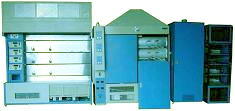Thermal
Oxidation
The oxide
of silicon, or silicon dioxide (SiO2),
is one of the most important ingredients in semiconductor manufacturing,
having played a crucial role in the development of semiconductor planar
processing. The formation of SiO2 on a silicon surface is most often accomplished through
a process called
thermal oxidation.
Thermal oxidation, as its name implies, is a technique that uses
extremely high temperatures (usually between 700-1300 deg C) to
promote the growth rate of oxide layers.
The thermal
oxidation of
SiO2
consists of exposing the silicon substrate to an oxidizing environment
of
O2 or H2O
at elevated temperature, producing oxide films whose thicknesses range
from 60 to 10000 angstroms. Oxidation of silicon is not difficult,
since silicon has a
natural inclination to form a stable oxide even at room temperature, as
long as an oxidizing ambient is present. The elevated temperature used
in thermal oxidation therefore serves primarily as an accelerator of the
oxidation process, resulting in thicker oxide layers per unit of time.
Thermal
oxidation is accomplished using an
oxidation
furnace
(or diffusion
furnace, since oxidation is basically a diffusion process involving
oxidant species), which provides the heat
needed to elevate the oxidizing ambient temperature. A furnace typically
consists of: 1)
a cabinet; 2) a heating system; 3) a temperature measurement and control
system; 4) fused quartz process tubes where the wafers undergo oxidation; 5) a system for
moving process gases into and out of the process tubes; and 6) a loading station used for loading (or
unloading) wafers into (or from) the process tubes.
 |
|
Figure 1.
Example of an
Oxidation Furnace
|
The heating
system usually consists of several heating coils that control the
temperature around the furnace tubes. The wafers are placed in quartz
glassware known as
boats,
which are supported by fused silica paddles inside the process tube.
A boat can contain many wafers, typically 50 or more. The oxidizing
agent (oxygen or steam) then enters the process tube through its source
end, subsequently diffusing to the wafers where the oxidation occurs.
Depending on
which oxidant species is used (O2
or H2O),
the thermal oxidation of
SiO2 may either be in the form of
dry oxidation
(wherein the oxidant is
O2)
or
wet oxidation
(wherein the
oxidant is H2O).
The reactions for dry and wet oxidation are governed by the following
equations:
1)
for dry
oxidation: Si (solid) +
O2
(vapor) -->
SiO2
(solid); and
2)
for wet
oxidation: Si (solid) + 2H2O
(vapor) -->
SiO2
(solid) + 2H2
(vapor).
During dry
oxidation, the silicon wafer reacts with the ambient oxygen, forming a
layer of silicon dioxide on its surface. In wet oxidation, hydrogen
and oxygen gases are introduced into a torch chamber where they react to
form water molecules, which are then made to enter the reactor where
they diffuse toward the wafers. The water molecules react
with the silicon to produce the oxide and another byproduct, i.e.,
hydrogen gas.
These
oxidation reactions occur at the
Si-SiO2
interface, i.e., silicon at the interface is consumed as oxidation takes
place. As the oxide grows, the Si-SiO2
interface moves into the silicon substrate. As a result, the Si-SiO2
interface will always be below the original Si wafer surface. The
SiO2 surface, on the other hand, is always above the original Si
surface.
SiO2 formation therefore proceeds in two
directions relative to the original wafer surface.
The amount of silicon consumed by the
formation of silicon dioxide is also fairly predictable from the
relative densities and molecular weights of Si and
SiO2,
i.e., the thickness of silicon consumed is
44%
of the final thickness of the oxide formed. Thus, an oxide that is 1000
angstroms thick will consume about 440 angstroms of silicon from the
substrate.
For oxidation
processes that have very long durations, the rate of oxide formation may
be modeled by a simple equation known as the
Parabolic
Growth Law
: xo2
= B t,
where
xo is
the thickness of the growing oxide, B is the parabolic rate constant,
and t is the oxidation time. This shows that the oxide thickness grown
is proportional to the square root of the oxidizing time, which means
that the oxide growth is hampered as the oxide thickness increases.
This is because the oxidizing species has to travel a greater distance
to the Si-SiO2 interface as the oxide layer
thickens.
Oxidation
processes that have very short durations, on the other hand, may be
modeled by another simple equation known as the
Linear Growth Law
:
xo
= C (t
+
t),
where
xo
is the thickness of the growing oxide, C is the linear rate constant, t
is the oxidation time, and
t
is the initial time displacement to account for the formation of the
initial oxide layer at the start of the oxidation process.
The Linear
and Parabolic Growth Laws were developed by Deal and Grove, and are
collectively known as the
Linear Parabolic Model.
This oxide growth model has been empirically proven to be accurate over
a wide range of temperatures (700-1,300 deg C), oxide thicknesses
(300-20,000 angstroms), and oxidant partial pressures (0.2-25
atmospheres).
Oxide growth
rate is affected by time, temperature, and pressure. More
specifically, oxide growth is accelerated by an increase in oxidation
time, oxidation temperature, or oxidation pressure. Other factors
that affect thermal oxidation growth rate for
SiO2 include:
the crystallographic orientation of the wafer; the wafer's doping level;
the presence of halogen impurities in the gas phase; the presence of
plasma during growth; and the presence of a photon flux during growth.
See Also:
Dielectric;
IC
Manufacturing; Wafer Fab Equipment
HOME
Copyright
© 2004
www.EESemi.com.
All Rights Reserved.

